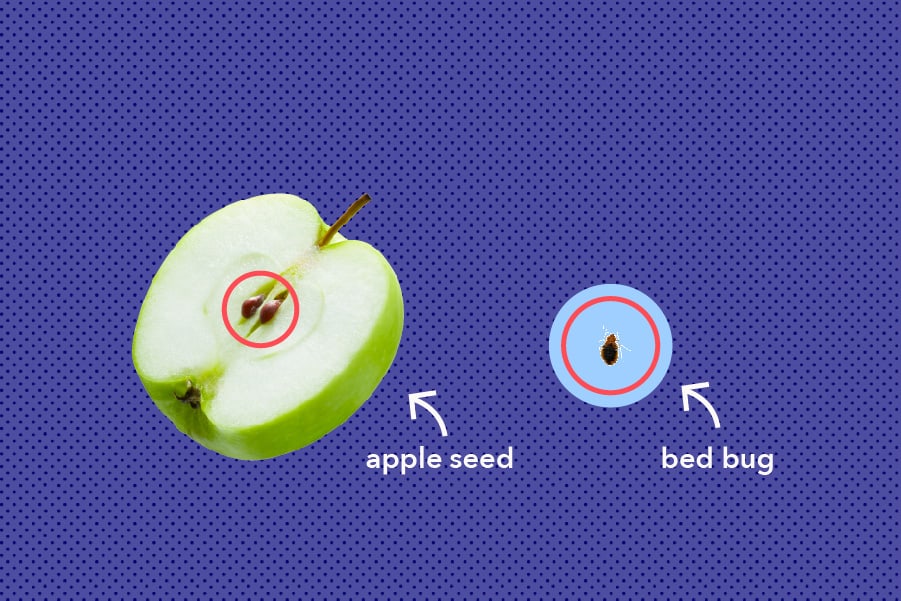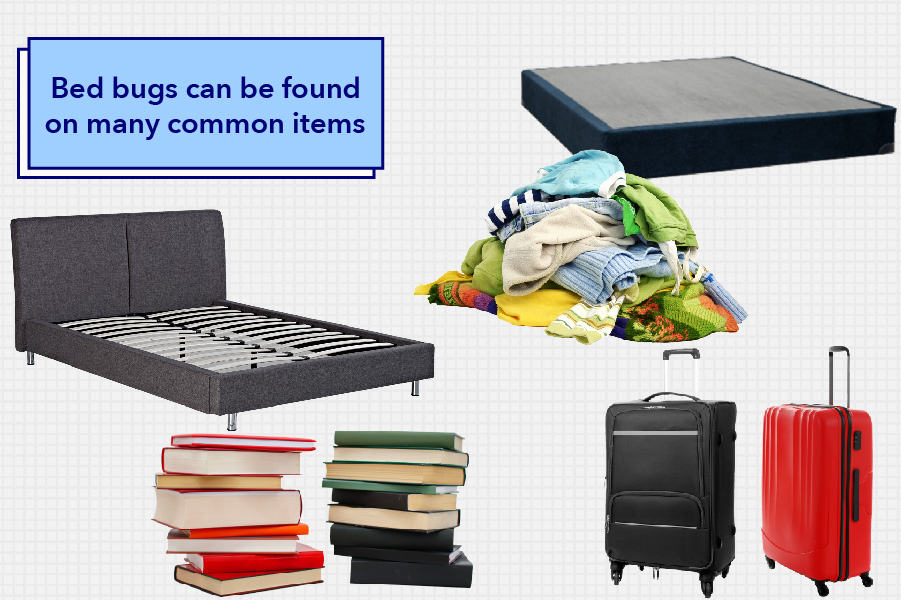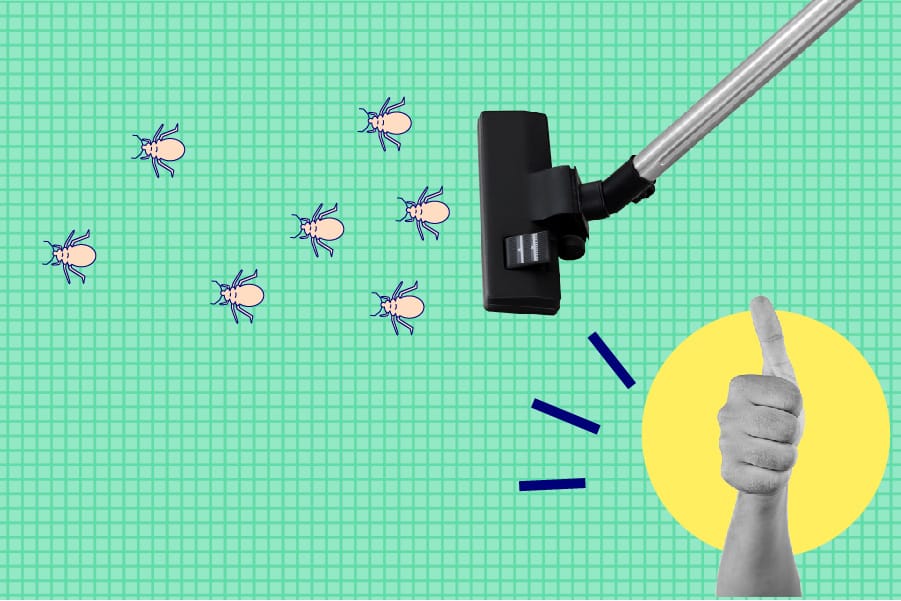Whether you’re dealing with a bed bug infestation or simply want to know how to avoid these pesky little critters in the first place, this is the guide for you. Here, I’m going to tell you exactly how to spot them, how to know if you have them, and, most importantly, how the heck to get rid of them.
Unfortunately, there’s no insta-fix cure when it comes to treating bed bugs. But, if you follow my simple three-step process, you’ll be well on your way to ridding your space of these blood-sucking insects.
So, without further ado, let’s get started!
Disclaimer: The best and most effective way to treat bed bugs is in concert with a professional exterminator. While you can do a lot of good work on your own, there’s no substitute for a professional team.
What are Bed Bugs?
Before you can get rid of bed bugs, you need to know a few things about how they work. There are plenty of creepy-crawly creatures that could be patrolling your bedroom, so you want to make sure you’re actually dealing with bed bugs before you start treating your space for them.
What They Look Like
First things first: What do bed bugs look like? Well, thankfully, most bed bugs look pretty much the same. They’re typically reddish brown in color and very, very small. If you’re looking to make a comparison, I’d say most bed bugs are about the size of an apple seed. So while they are definitely tiny, they’re still visible to the naked eye.
I should also mention that they can’t fly, which makes spotting, trapping, and eventually exterminating them all that much easier.

Where They Hide
Knowing what they look like is important, but it’s also crucial to think about where these little critters like to hide. Unlike other pests, bed bugs don’t make nests, but they do tend to congregate in large groups. They’re preferred hiding holes? Nooks, crannies, and large piles of clutter.
In the bedroom, they tend to go for box springs, luggage, mattresses, bed frames, books, and even clothing. So… basically everywhere. How fun!
How They Feed
And the last habit to consider is how bed bugs feed, which actually informs where they hide and what they look like. Why? Because they feast on human blood! Yep, these little guys are basically insect Draculas that emerge at night to prick and feed on your hemoglobin.
That’s why they mostly hang out by beds, because their favorite feeding time is whenever their human host is sleeping. They bite and drink for approximately 3 – 10 minutes at a time, or until they’re engorged with blood. And this my friends is what gives them their red color. Talk about disgusting!

How to Know if You Have Bed Bugs
So, we’ve got a basic understanding of what’s going on with bed bugs, but how do you know if your place has actually been infested by these hard-shelled vampires?
Well, you’ll know if you have bed bugs because you’ll wake up in the morning with bites on your skin. Though there are plenty of critters that like to munch on flesh in the night, you’ll notice bed bug bites only on skin that was exposed while you were snoozing. A surefire way to differentiate a bed bug bite from one of a flea or a mosquito is that bed bug bites eventually turn into red welts that itch like a youknowwhat.
Aside from bites, other ways to tell if you’re dealing with a bed bug infestation are the marks they leave behind. Crushed bed bugs will leave a red residue the size of a period mark. Sometimes, you’ll see bed bug eggs in your sheets, which are yellow in color. And if the bed bug fed for a long time, you may even notice your own blood staining the sheets (don’t worry the bites are usually painless, if that’s any consolation!)
How to Get Rid of Bed Bugs
Alright, now for the tough part. Fortunately, it’s totally possible to rid your home of bed bugs. Unfortunately, the process by which you do this is a little cantankerous and can take a long time. Bed bugs are resilient creatures, so the key here is to go extreme with everything you do.
Step 1: Vacuum
First and foremost, you’ll want to vacuum the bejeezus out of any and all potential hiding places! You can hire an expert to come over and identify these spots or you can simply take a vacuum to areas that look like definite bed bug hangouts, like your mattress, bed frame, couch cushions, baseboards, and box spring. You’ll want to use a vacuum because it is the most effective tool for removing bed bugs (remember, they’re fast, so trying to catch them individually would definitely be a fool’s errand).

Once you’ve thoroughly vacuumed every nook and cranny, seal up the vacuumed contents into a plastic bag and throw it away. Make sure to thoroughly clean your vacuum afterward! Repeat this process as many times as you’d like (two to three times should suffice).
Step 2: Burn it up, Freeze it Down
Next up, it’s time to deal with all your linens and clothes. I recommend washing and drying these goods as quickly as you can. Wash them on the highest possible temperature setting and then dry them on high. Bed bugs hate extreme temperatures, so you’ll want to try to get temps up to at least 115 degrees Fahrenheit (46 degrees Celsius) or down to 32 degrees Fahrenheit (0 degrees Celsius).
If you’ve got stuff that won’t work in a washer/dryer, you can put them in black bags and either set them in the freezer overnight or leave them outside, if you live in a particularly hot climate.
Anything that can’t be treated with these methods needs to be thrown away immediately. Put them in sealed bags and toss them out. This includes mattresses, couches, chairs, you name it! If you do chuck them out curbside, make sure to clearly mark that they’ve been infected with bed bugs in order to stop the spread.

Step 3
And finally, it’s time to move in with the big guns: Insecticides. These agents will stop bed bugs in their tracks and rid your space of these creepy crawly nightmares. You can apply the insecticides on your own or hire a professional exterminator to get the job done.
It’s worth noting that no insecticide is going to magically clear the affected area of all bed bugs. There are simply too many bugs in too many places for one single pass of any treatment to eradicate the situation entirely. However, with methodical use and persistence, you’ll be able to de-bug a room. And when it comes to what kinds of insecticides you should use, some of the most popular options on the market include:
- Desiccant Dusts: Low-toxicity dusts like silica aerogel and diatomaceous earth can be great for treating bed bugs. The way they work is by desiccating or “drying out” any bed bugs they come in contact with. Safer for humans than liquid-based sprays, these dusts can be applied to box springs, baseboards, and wall seams with a paint brush. If you’ve got a lot of nooks and crannies in your space, you’ll definitely want to employ these products extensively.
- Contact Sprays: Another fantastic low-toxicity option is a direct contact spray. These sprays only really work if applied directly on a bed bug, so if you can visibly see a group of them, this could be a good option for you. However, once the liquid dries, it’s no longer potent, which means you’ll have to spray several times to keep the extermination going. SteriFab™ and Bedlam® are solid examples of low-toxicity contact sprays.
- Pyrethroid Insecticides: And last but not least, let’s talk about pyrethroid insecticides. These are the kinds of powerful sprays you likely imagine when you think of exterminating a bed bug issue. They’re strong, toxic, and extremely effective… as long as they’re applied correctly. Most of these insecticides come with clear instructions on how to use them and it is not recommended to go against these instructions. While not harmful for adults, these insecticides should not be used around children. Though they’re likely to curb your bed bug problem, most bed bugs have built up at least some tolerance to these insecticides. So, you may have to treat (and re-treat) an area multiple times before seeing results.
It’s worth mentioning again and again: Never, ever, EVER use a pesticide for bed bugs that doesn’t clearly state that it can be used indoors. And do NOT apply any sprays directly to your skin or the skin of other folks in your home.
After Care
Once you’ve vacuumed all the major bed bug hiding spots, cleaned your linens, and sprayed the area with insecticide, there are a few more things you need to do.
Firstly, you’ll want to wrap up your bed in a protective bug-repellant cover. You can easily buy these at most large-chain super stores or online. Sealing up your mattress will kill old bed bugs still lurking in the layers and prevent new ones from hopping on.
Next, you may want to consider slipping interceptor cups onto the posts of your bed frame. These products make it difficult for bed bugs to climb up the posts and bite you in your sleep. Several of them now come with sticky interiors that can also trap these bugs, which will allow you to mark your extermination progress. No more bugs in the cup, no more bugs in the room!
And lastly, you’ll want to keep a very close watch over your space. Unfortunately, bed bugs are resilient, so are known to come back to areas even after they’ve been thoroughly cleaned. So, it’s important to stay vigilant for the first few weeks after treatment. One way to do this is to keep clutter to a minimum and to regularly check corners, behind cabinets, and underneath beds for any signs of life. I’d also suggest vacuuming a ton in the first few months of an infestation.
FAQs
Well folks, we’ve almost made it to the end of this video! And to wrap things up, I thought I’d answer some of the most frequently asked questions I get about bed bugs here at Sleepopolis.
What is the main cause of bed bugs?
Unbeknownst to most folks, the biggest culprit of bed bugs is travel. You’d think it would be dirty or cluttered spaces, but bed bugs actually latch onto clothes, luggage, and fabrics in a totally indiscriminate way, meaning they can affect anyone and any home.
What kills bed bugs instantly?
Extreme temperatures! Freeze your clothes, wash your sheets at high temperatures, do whatever you can to treat everything in your home with as much extremity as possible. The easiest way to accomplish this is to throw things into your washer/dryer on high temperature settings.
What is the first sign of bed bugs?
The first signs of bed bugs are typically bite marks on the body, blood stains on your sheets, and an itching sensation. You may also notice shed bed bug skin or yellowish eggs.
Can bed bugs be completely eliminated?
Thankfully, yes, but it does take a very, very long time. The most effective way to rid your space of bed bugs is to do an excellent job of cleaning at the start of the infestation and to keep the cleaning routine going for the first few weeks afterward to prevent it all starting again.